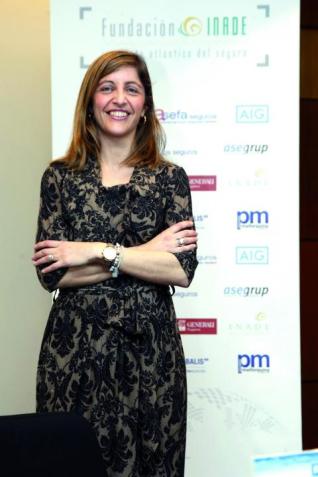'Insurance for kidnappings by pirates gives access to the best negotiators'
Source: FARO de Vigo (Spanish Language)
Having a special policy for cases of kidnapping is key, as insurers, to ensure that the problem is solved as soon as possible, something that resort owners especially since 2011, with the increase in piracy in the Indian Ocean. These provide access to insurance professionals and former members of the security forces of the countries belonging to the hijackers, intelligence personnel or negotiating NGOs, with governments, and with the pirates for the release in exchange for a ransom.
Maria Victoria valentine-Gamazo - Special Risk Underwriter AIG

|
Maria Victoria Valentine-Gamazo, before conference. Img: Inade Foundation
|
MANUEL BARRAL - (VIGO) Pirate attacks and kidnappings in recent years in waters around the world have led to a surge in hiring special insurance for shipowners. The Special Risk underwriting department of AIG Financial Lines, Maria Victoria Valentine-Gamazo, who recently participated in a conference organized by the Foundation Galicia Inade, Atlantic Security Institute, says the biggest increase in demand for these policies was recorded in 2011.
Her presentation was titled "Risk analysis of kidnapping and ransom (K & R)." Has there been an increase in the provision of insurance to address the risk of kidnapping in the maritime sector?
-The rebound came after the incidents of 2011 in the Indian Ocean by Somali pirates. That year there were 28 kidnappings in the area and 237 pirate attacks, which represented an increase of 40% over 2010.
- What aspects are analyzed to offer this insurance?
With regard to maritime risk, it is the waters in which the insurance applicant sails. Regarding the characteristics of the vessel, there are several things. The freeboard height (the distance between the maximum depth and the main cover), which determines the degree of accessibility by the pirate (for example, a fishing boat such as a tuna vessel is susceptible to pirate attack), the speed of ship and security measures on board (from hiring private security to the existence of Citadel or cage that serves as bunker to preserve the crew [safety]), the compliance with BMP4 (best management practices for protection against Somali piracy attacks) for vessels navigating in the area of influence of the Somali pirates and crew training on such incidents.
- What waters do insurers categorize as more insecure?
-The Indian Ocean remains where there is a greater risk by threat of pirates, especially Somalis. However there is a rising risk in the Gulf of Guinea by Nigerian pirates activity. Also in the Gulf of Oman, Gulf of Aden and the Red Sea. However, also to be considered in the highest risk zone, is the Indian Ocean, from 2012 there is a greater presence of security forces of NATO, which has reduced attacks by 70%. That's good news for the other side but bad because the difficulty in making pirate attacks, when they achieve their goal, it raises requests for rescue attempts.
- How do the kidnappers operate in maritime piracy?
-It depends on the area. Both Somalis and Nigerians are affected by meteorological conditions, reducing attacks during monsoon. In Somalia they have more experience, speedboats with speeds of 25 knots and more attacks may occur at any time of day. In Nigeria, a former officer highlights the involvement of the country's naval forces. Cutting the vessel communication systems and abduction duration varies from 1 to 11 days. They are also very violent. The cargo is one of its main objectives. Pirates take over the ship and transfer the load to their boats.
- What is the amount generally claimed for a maritime hijacking?
-The average ransom has risen from 4 million dollars claimed in 2010 to five million in 2011 [in Somalia]. But there is talk that the largest ransom payment reached 10 million.
-Insurers always coordinate with the Government in the negotiation but what actors involved in the talks? Do you also involve the owner?
-These insurers offer insurance consulting, crisis management specialist professionals whose coordinated operation in collaboration with the governments involved (the country where the incident occurs, the country to which the crew and from which the operator or owner of the vessel). The owner can be actively involved in such incidents if they are a policyholder.
-You provided data on duration of kidnappings, places where they occur, which affects people and average costs as appropriate. Is there a clear profile in maritime hijackings?
-It varies by which waters and the origins of the pirates. There is no clear duration and it must be taken into account that not all cases are reported, and there is data of kidnappings lasting up to 3 years. Regarding people considered kidnap objectives by pirates, the Western crews have a higher value compared to the locals, which determines the ransom request. Finally, the pirates have skillfully used the families of the kidnapped crewto intimidate them achieve and greater amount of ransom.
- Why is it said that the critical coverage for both risk insurance on land and sea, are the crisis management consultants?
'Because this is the biggest cost a company would have to take in solving these kinds of incidents, far more than the price you can finally achieve the rescue. Having expertise allows cases to be resolved, before the victim is released and has people who can cooperate with local governments, with a greater understanding of the problems of each country and even the media, as Is necessary. Keep in mind that these are people who have been in law enforcement, NGOs, or intelligence personnel, and in many cases, if not for the insurance, companies do not have access to these specialists.
 Subscribe to our newsletter. Receive a weekly round-up of all piracy-related news.
Subscribe to our newsletter. Receive a weekly round-up of all piracy-related news.
OCEANUSLive.org
Information, Security, Safety; Shared
Submitted by Team@oceanuslive.org